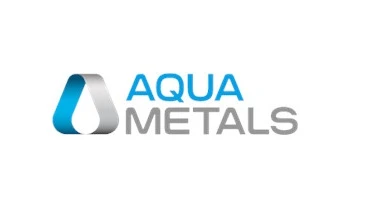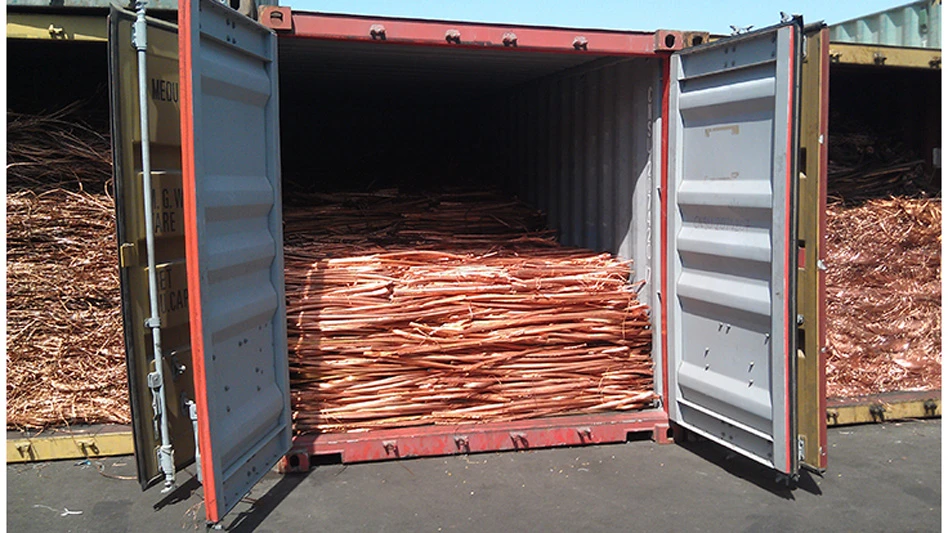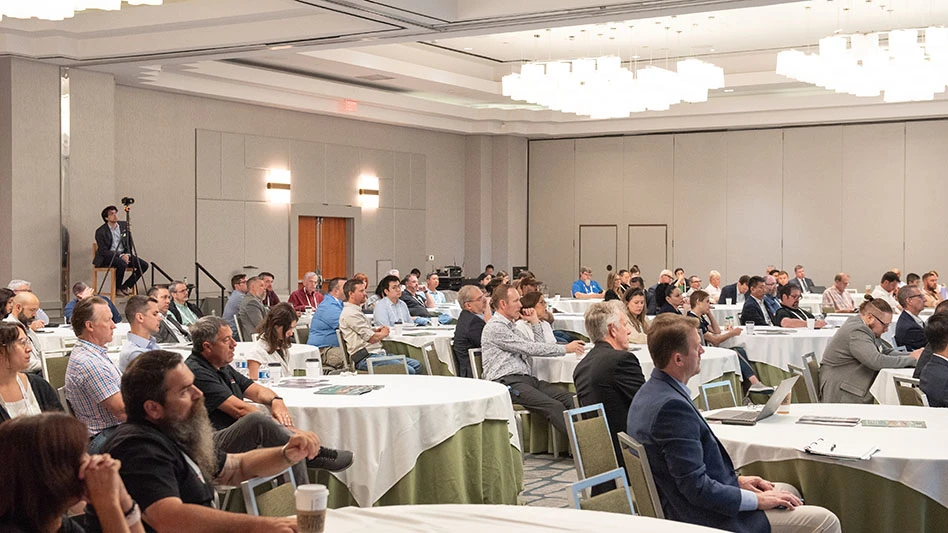Attendees of the National Recycling Coalition’s (NRC) 23rd Annual Congress and Exposition descended on San Francisco’s Moscone Convention Center in late August. The city, known for its progressive approach to recycling and conservation, provided a lively backdrop to the convention’s events.
When not networking at the welcoming reception aboard a Hornblower yacht or at the Taste of San Francisco event sponsored by Norcal Waste Systems and the California Resource Recovery Association, convention attendees could also sign up for various tours of waste reduction facilities. The tours offerered included a construction and demolition facility tour, the Davis Street Station material recovery facility in San Leandro and electronics recycling tour that included Compumentor, an electronics recovery facility in San Francisco.
In addition to exploring an exhibit hall populated with equipment and service providers to the recycling industry, attendees could also attend a variety of educational sessions ranging from the health of commodity markets to tips for increasing diversion in municipal recycling programs to the ins and outs of electronics recycling.
NAVIGATING ELECTRONICS RECYCLING. A panel comprised of Recycle America Alliance’s (RAA) Kevin McCarthy, Panasonic’s David Thompson and Good Point Recycling’s Robin Ingenthron discussed ethical and economical recycling of scrap electronics at an educational session during the conference.
The topics covered in their presentations included product stewardship, unregulated exports and design changes that will facilitate electronics recycling
"EPA has done a phenomenal job in trying to push product stewardship forward," McCarthy of RAA, a subsidiary of Waste Management Inc., Houston, said.
Despite this effort by the EPA, e-scrap remains difficult to manage because of the hazardous components these devices contain, their low residual value, the immature laws and regulations governing e-scrap recycling, the inadequate domestic recycling infrastructure and the conflicting agendas of the stakeholders, he said.
McCarthy said that the industry has a long way to go in establishing a recycling infrastructure for electronics. He cited the negative influence of the e-scrap "axis of evil," which includes unregulated export markets, bad actors and prison labor. He also urged municipalities and companies to shy away from recyclers that use prison labor in favor of supporting real-wage, local jobs.
McCarthy offered the following tips for the design of effective and sustainable e-scrap recycling programs: building on the existing infrastructure rather than developing a new infrastructure to collect and transport the material; focusing on high-profile items with high diversion potential rather than smaller items, such as coffee pots and toaster ovens; getting customers used to paying a small fee to recycle their electronics; seeking out partnerships with charities; referring to the volume of material collected in pounds rather than in tons; and sharing successes throughout the industry.
Thompson of Panasonic, with U.S. headquarters in Secaucus, N.J., discussed some of the design changes occurring at Panasonic in response to the EU’s RoHS (Restriction on Hazardous Substances) Directive, which calls for the elimination of hazardous materials, such as lead, in electronic components.
Ingenthron of Good Point Recycling, Middlebury, Vt., looked at the supply and demand forces at play in international markets. He said he did not believe the United States should adopt a "no-exports" policy, which would mean that reusable electronics would end up being destroyed while still viable.
Ingenthron proposed that the solution to export problems is to set higher standards, such as the CRT glass test that his company developed and that the Basel Action Network has adopted.
INNOVATION IN ACTION. A session titled "Profiles in Innovation" offered a glimpse at a few of the country’s most innovative and successful recycling programs, including those in the convention’s host city, Ann Arbor and San Jose.
Robert Haley, recycling program manager of SF Environment, offered information on San Francisco’s successful diversion program, which hopes to reach a 75 percent diversion goal by 2010 and zero waste by 2020. The city encourages the highest and best use of all the material it diverts from the landfill, he added.
San Francisco’s Fantastic 3 recycling program was developed in conjunction with Norcal Waste. Haley said that Norcal does not own a landfill and prefers to feed material into its recycling and composting programs.
Haley said that the city is considering mandatory composting and recycling and is also asking food service companies to move away from disposable goods.
Melinda Uerling, executive director of Recycle Ann Arbor, said the city boasts a 40 percent diversion rate; 22 percent of the diverted material is recycled, while 18 percent is composted.
Recycle Ann Arbor has established elements of its contract to maximize recovery. The more material recycled, the more Uerling’s organization benefits, she said, adding that Recycle Ann Arbor is "committed to quality and quantity."
Recycle Ann Arbor benefits the city by increasing recovery while improving the quality of the material collected; providing a base of support and community ownership; and acting as a seed for other diversion programs, she said.
Although successful, the program is not without its challenges, Uerling said. She cited the abundance of landfill space in Michigan and the struggle to keep the recycling message fresh and to avoid complacency.
Stephen Bantillo of the city of San Jose said the city enjoyed a 62 percent diversion rate in 2002, a slight dip from the 64 percent it recorded in 2000.
As an incentive to increase diversion, the city’s contractors get to keep revenues generated from the sale of the recyclables, Bantillo said. San Jose moved to single-stream collection in 2000, offering incentive payments for the percentage of material recycled.
The city offers non-exclusive franchises to waste haulers, the cost of which is based on the cubic yards of garbage service, not on the amount of recyclables.
While speakers at the NRC’s Annual Congress typically touch on many "municipally oriented" subjects, such as zero waste and promoting curbside recycling, several sessions focused on the dynamics driving markets for many secondary commodities.
CHINA’S INFLUENCE. In the session titled "The Challenge for Recovered Paper Markets," three speakers talked about many of the dynamics that have been changing the overall fundamentals of the paper business.
Bill Moore, principal of Moore & Associates, a consulting firm for the secondary paper business based in Atlanta, contrasted the North American paper industry with that of China’s. While domestic paper companies have not increased production capabilities during the past several years, new production in China has been surging.
Mark Starnes, vice president of Weyerhaeuser Recycling, Federal Way, Wash., touched on a host of the fundamentals that are now changing the overall dynamics of the domestic paper industry. While the market is moving upward, quality issues need to be addressed if the paper industry hopes to see recovery levels continue to grow.
A second session, "Impact of Exports on Domestic Markets and Program Sustainability," looked at the export market, not only for paper, but also for plastic containers.
Stan Lancey, a chief economist with the American Forest & Paper Association, Washington, said the United States had a glut of recovered fiber in the 1980s. However, he added, the domestic paper industry has done a very good job of boosting the paper recovery level.
Lancey said that China has become a major factor in markets for most grades of paper. He noted that exports to China jumped by 64 percent last year, with further increases expected this year.
While paper markets have surged thanks to the growth in China’s market, it is not the only material that has seen its fortunes changed.
Floyd Flexon with Amcor Packaging of Manchester, Mich., one of the largest plastics packaging companies in the United States, said that China is also having a major impact on plastics markets. In fact, several people say the number of domestic plastics reclaimers is dwindling in light of the surge in offshore shipments.
Flexon noted that massive construction of processing capacity currently taking place in China is slated to come on line by 2006. While this means the scrap plastics should see good prices, it also could hurt the U.S. plastics reclaiming market.
During a session on the overall commodity markets, commodity representatives put their best case forward for the success of their particular commodity.
Michael Sullivan with Abitibi-Consolidated’s Recycling Division, Houston, Texas, echoed what many people have been saying about the China market. One advantage that his company does enjoy is the fact that the company has invested in significant new capacity in China and the Pacific Rim.
Next year’s NRC Congress will be held in Minneapolis Aug. 29-31.
The authors are associate and senior editor of Recycling Today and can be contacted at dtoto@gie.net and at dsandoval@gie.net.

Explore the October 2004 Issue
Check out more from this issue and find your next story to read.
Latest from Recycling Today
- USTR announces phased measures designed to address China’s shipbuilding dominance
- APR, RecyClass release partnership progress report
- Clearpoint Recycling, Enviroo sign PET supply contract
- Invista expanding ISCC Plus certification program
- Redwood partnership targets recycling of medium-format batteries
- Enfinite forms Hazardous & Specialty Waste Management Council
- Combined DRS, EPR legislation introduced in Rhode Island
- Eureka Recycling starts up newly upgraded MRF





